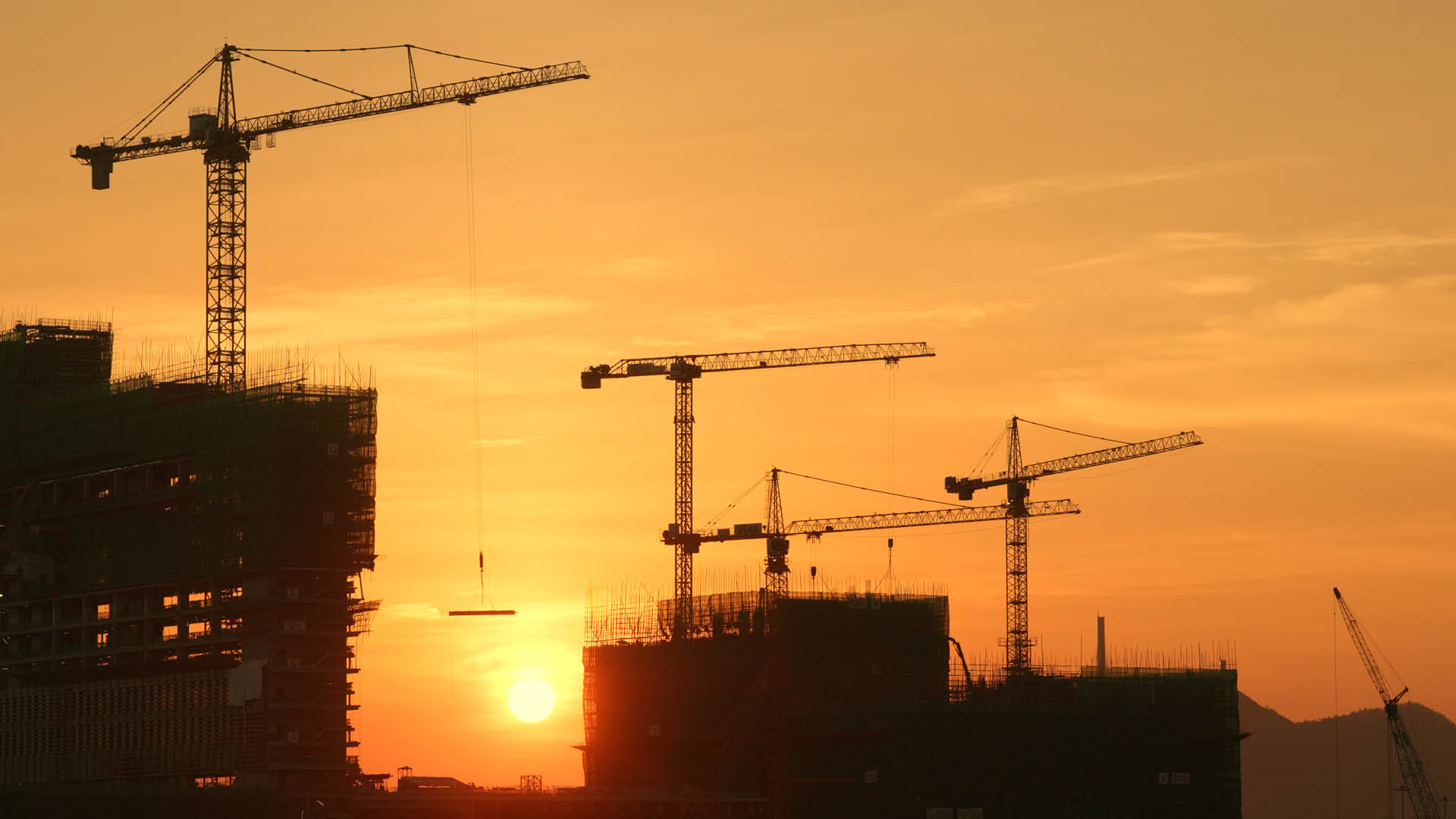Publication

AI and the construction industry: emerging technologies and the demand for advanced infrastructure
Middle East | Publication | July 2025
- Introduction
- Summary of key takeaways
- Emerging technologies and the demand for advanced infrastructure
- What makes these data centre construction projects unique?
- What are the key construction considerations unique to the Middle East?
- How can these unique risks be mitigated during construction of data centres?
- Conclusion
Introduction
Organisations across all sectors are increasingly leveraging emerging technologies like artificial intelligence (“AI”), 5G technology and the internet of things to drive operational efficiency, enhance customer engagement and expand their market presence. This technological shift is fuelling unprecedented demand for robust digital infrastructure, with data centres at the heart of this transformation.
As the backbone for processing, storing and securing the vast quantities of data generated by these technologies, we are seeing a rapid growth in data centres. However, this expansion brings with it a host of technical and practical challenges, ranging from the physical demands of constructing and operating facilities, heightened energy requirements and evolving regulatory obligations, to the need for stringent data governance.
For businesses and industry stakeholders the growth of data centres presents significant opportunities for innovative construction projects. However, particularly in regions like the Middle East, where environmental factors add further complexity, careful planning is essential to mitigate the risks of these complex projects. In this article, we explore the key legal and practical considerations for developing and operating data centres, offering insights to help organisations manage risk and seize the opportunities presented by digital transformation.
Summary of key takeaways
- UAE commitment to emerging technologies: The UAE has reinforced its commitment to the development of emerging technologies by forming the Artificial Intelligence and Advanced Technology Council (“AIATC”), signalling strong governmental support for the development and integration of AI and related technologies.
- Major infrastructure milestones in 2026: Several landmark data centre construction projects in the United Arab Emirates (“UAE”) and the Kingdom of Saudi Arabia (“Saudi Arabia”) will be completed in 2026, marking a pivotal year for the region’s digital infrastructure.
- Specialised nature of data centre construction: Data centres require highly specialised infrastructure to securely house and manage vast amounts of critical digital information. They require exceptional reliability, advanced security measures and significant energy capacity, distinguishing data centre projects from other forms of construction.
- Regulatory developments in Saudi Arabia: The Communications, Space and Technology Commission recently released the 2025 ‘Global AI Hub’ draft law. If enacted, this would enable the creation of sovereign data centres or distinct, physically separated and clearly defined areas within a data centre known as ‘hubs’, located within Saudi Arabia.
- Challenges when constructing data centres in the Middle East: Access to power, built-in redundancies, robust physical security and effective cooling systems remain among the most significant challenges when constructing new data centres in the Middle East.
- Construction risk mitigation: A combination of early expert engagement, proactive supply chain management and careful programme development can reduce the risk of costly disruptions, accommodate the unique complexities associated with the construction of data centres in the region, and future-proof projects.
Emerging technologies and the demand for advanced infrastructure
Emerging technologies are rapidly transforming the construction industry, driving a surge in demand for advanced infrastructure – particularly data centres, which serve as a backbone for the digital world. Data centres are highly secure facilities that house computer systems and associated components such as servers, storage devices, networking hardware, and backup power systems. They are crucial for hosting websites, running applications, processing data, hosting cloud computing and powering AI models.
This trend of increasing demand for advanced infrastructure is particularly strong in the Middle East, with various governments and businesses investing heavily into data centres to support digital transformation targets. The UAE has reinforced its commitment to the development of emerging technologies through the formation of AIATC. AIATC’s goal is to accelerate the deployment of cutting-edge infrastructure by building on existing national investments and collaborating with leading global technology and investment partners.
Various data centre projects are underway across the region, with many expected to reach completion in 2026, illustrating the region’s commitment to digital transformation and technological advancement. Some notable developments within the UAE and Saudi Arabia include:
- Amazon Web Services (“AWS”): A new AWS region is being established in Saudi Arabia and is scheduled for completion by 2026. This project represents a significant long-term investment of over $5.3 billion. The new AWS region will consist of three availability zones that are connected by redundant, ultra-low-latency networks to ensure business continuity and high availability. This will allow organisations to run their applications and serve users directly from within Saudi Arabia. It will also support those who need to store and process data within Saudi Arabia, in compliance with data localisation requirements.
- Khazna: Two major data centre facilities in the UAE - one in Mafraq and another in Masdar City - are scheduled for completion in August and December 2026, respectively. These projects will feature a modular design to enhance construction efficiency and will incorporate evaporative free cooling systems to reduce energy consumption. Backed by prominent regional and international investors, Khazna has also secured additional funding in 2025, reinforcing its position as a dominant force in the region’s data centre landscape.
- Alfanar Global Development: Four data centres are being established in Saudi Arabia following a $1.4 billion investment. These facilities are designed to support cloud computing and AI-driven solutions for both public and private sector clients. Strategically located in Riyadh and Dammam, the projects are being developed with a strong emphasis on sustainability and alignment with national green energy goals.
- Mubadala Investment Company: As one of the UAE’s sovereign investment arms, Mubadala Investment Company, has deepened its presence in the hyperscale data centre space through a strategic investment in Yonder Group, a global developer, owner and operator of hyperscale data centres. Yonder, known for serving major blue-chip technology clients, currently operates nearly 60MW of capacity with a pipeline exceeding 800MW, underscoring the scale and ambition of its regional partnerships.
What makes these data centre construction projects unique?
Unlike many other types of commercial or industrial construction projects, a data centre is purpose-built to house and protect vast amounts of critical digital information. This unique function requires highly specialised infrastructure, exceptional reliability, layers of redundancy and significant energy consumption capacity.
Power infrastructure and high energy demands
As technology evolves and the volume of internet traffic continues to rise, the demand for computing resources – and consequently, operational servers housed in data centres – is rising. To keep these servers running efficiently, data centres consume colossal amounts of power. The International Energy Agency reported that data centres (excluding those processing cryptocurrency mining) consumed between 1 to 1.3 percent of the global electricity demand in 2022. As such, proximity to a stable high-capacity power grid and access to reliable connectivity are critical considerations in site selection and infrastructure planning. To meet these demands, many data centre projects now include the construction of dedicated electrical substations as part of their development.
The uninterrupted operation of a data centre is essential, as even brief downtime can result in disastrous commercial and reputational losses as well as data loss or corruption. To mitigate this risk, many data centres are being designed with redundant power systems, including backup generators, and uninterruptible power supply systems, to ensure continuous operation – even in the event of a grid failure.
Beyond traditional grid connections, many data centre operators are exploring on-site renewable energy generation, entering into corporate agreements with nuclear power plants, deploying energy storage solutions, and using smart grid integration to enhance energy security and sustainability. These strategies not only support operational continuity but also align with broader regional objectives for energy diversification and focus on net-zero.
Cooling systems and water access
Data centre servers generate enormous amounts of heat, and efficient cooling systems are essential to prevent overheating and failure of the dense server configurations. This is especially important for data centres built in climates with extreme temperatures, like those in the Middle East, where maintaining optimal operating conditions can be particularly challenging.
Common methods currently used to address these thermal challenges include:
- Air cooling: Using air conditioning, fans and vents to circulate ambient air and expel the heat generated by equipment.
- Liquid cooling: Using coolants that circulate through a network of pipes, absorbing heat away from the servers and other equipment.
- Immersion cooling: Submerging components in dielectric fluids that cool the equipment by absorbing heat.
- Evaporative cooling: Using fans to draw in outside air, cooling it through evaporation and deploying it to lower the temperature of the equipment.
- Free cooling: Using external conditions, primarily cool external air or water, and systems such as thermal wheels and plate-heat exchangers to reduce reliance on mechanical cooling.
- Hybrid cooling: Integrating multiple cooling technologies to optimise thermal management based on the specific equipment demands and environmental conditions.
Securing a reliable water supply for cooling purposes, especially in systems that use evaporative cooling methods, is a key part of construction planning. Modern data centres increasingly incorporate architectural and engineering strategies – such as raised floors, hot and cold aisle containment, and precision air conditioning systems – to enhance airflow and prevent localised overheating.
Security and strategic location
A detailed data centre strategy must account for physical, cyber and geographical security considerations. With highly sensitive digital information at stake, physical security is paramount. Developers and operators implement robust access controls, advanced surveillance, and physical barriers to prevent unauthorised entry and ensure the safety of critical infrastructure.
Strategic site selection is equally crucial. The right location minimises risks that could lead to downtime, financial loss, reputational damage and decreased trust from stakeholders. Environmental risks like sandstorms, extreme temperatures, floods and other natural disasters must be carefully assessed and mitigated. Mitigation steps include incorporating reinforced foundations and resilient infrastructure to ensure uninterrupted operations.
The proximity to end-users is key for performance. The closer the data centre is to its end-users, the lower the latency and network congestion, which improves overall speed and reliability. Even small delays - ranging from single-digit milliseconds to triple-digit milliseconds - can impact real-time applications. As demand for low-latency, high-availability services continues to grow, data centre developers in the Middle East and beyond are prioritizing resilient design, advanced security protocols, and strategic geographic positioning to deliver reliable, high-performance services.
What are the key construction considerations unique to the Middle East?
Thermal management
In a region where atmospheric temperatures can reach extreme levels, cooling the physical infrastructure is a major concern. Given traditional air conditioning systems have proven to be inefficient and costly, strategic design and optimisation are essential for ensuring that data centres operate effectively.
To protect cooling systems, direct sunlight must be avoided, and all external-facing piping and ductwork should be heavily insulated to minimise thermal gain. In tandem with the sophisticated cooling systems outlined above, other strategies to optimise data centre cooling include:
- Hot/ cold aisle containment: Server racks are arranged to separate hot and cold air, ensuring cool air reaches the equipment and hot air is extracted.
- Optimising airflow management: Vents and barriers are used to eliminate stagnant air zones, allowing for effective airflow management which reduces cooling costs and maintains stable temperatures.
- Humidity control: Maintaining appropriate humidity levels to prevent hardware damage and reduce the risk of static electricity.
Looking ahead, adaptive cooling methods, including those powered by AI to continuously learn and adjust to the specific cooling needs of a data centre, are poised to transform thermal management. By combining advanced cooling technologies with intelligent design and automation, operators are reducing energy consumption and supporting sustainability – even in the region’s harshest climates.
Energy efficiency
Energy efficiency remains crucial as the region pursues ambitious environmental targets. By optimising cooling systems, operators can significantly reduce their environmental footprint and costs. Many operators are also investing in renewable energy sources, including solar and wind, to enhance energy independence.
A comprehensive approach to sustainability combines renewable energy integration, energy-efficient hardware and storage solutions like fuel cells and high-capacity batteries, and innovative building materials with high thermal resistances. These measures reduce cooling loads and improve overall energy performance, allowing data centres to minimize their environmental impact.
As the demand for digital infrastructure grows, energy efficiency is no longer optional. Governments and industry leaders are responding with green building standards, incentives for clean energy adoption, and encouraging innovation in sustainable design. These efforts not only reduce the environmental impact of data centre growth, but also position the region as a hub for climate-conscious digital innovation.
Data localisation
Data localisation requires specific data that originated in a country to be collected, processed, and/ or stored within that country. This can result in major hurdles for cross-border businesses by creating logistical, financial and operational complexities. Saudi Arabia and the UAE both have data localisation requirements, but their approaches differ in scope and application. Saudi Arabia has introduced strict data localisation requirements, particularly for sensitive and government-related data. In contrast, the UAE has taken a more flexible approach, allowing certain cross-border data transfers while still imposing localisation obligations in specific regulated sectors like banking and healthcare. Both countries impose significant penalties for non-compliance and businesses operating in these jurisdictions must carefully consider how and where they process and store data. This can often necessitate the construction of additional data centres solely to comply with data localisation requirements.
How can these unique risks be mitigated during construction of data centres?
The complexities and risks set out in the sections above can have a significant impact on the entire lifecycle of the data centre. Failure to identify and mitigate challenges appropriately can result in costly repairs and delays in construction. Some key mitigation methods include:
- Early expert engagement: Involving technical, design and planning specialists from the early planning stages is essential. Their expertise enables the identification of project-specific challenges and tailored solutions. Delaying expert involvement can lead to significant and costly defects or necessitate multiple design revisions once construction has already commenced.
- Proactive supply chain management: Where the project requires bespoke or highly specialised equipment, developers must take a proactive approach to managing both the supply of materials and the availability of specialist labour for installation and commissioning. Given there is often a limited pool of sufficiently qualified suppliers and installers who can build complex and innovative systems, any lapse in supply chain management can result in substantial delays to the construction programme.
- Thoughtful sequencing of works: It is equally important to seek input from experts and specialist suppliers alike when developing the construction programme. This allows any unique installation requirements to be incorporated into the programme from the outset, reducing the risk of having to reprogramme the works during construction. This also facilitates the early identification of potential technical challenges – particularly in relation to complex systems integration or commissioning – and enables the inclusion of sufficient float in the programme to minimise the impact of any technical issues on the critical path and other contractors/ suppliers.
Conclusion
As the world continues to explore the use of emerging technologies and integrates the associated efficiencies into daily business operations, the demand for robust, innovative, secure and locally compliant data centres in the Middle East is set to accelerate. These projects present distinct regional challenges – particularly around regulatory compliance and operational resilience – and early engagement with specialised design and planning experts is essential. By doing so, projects can avoid critical mistakes that threaten the use and reliability of these centres and future-proof data centres against evolving technological, environmental, and legal requirements.
Recent publications

Publication
Global Asset Management Review: Issue 4
Welcome to the third issue of Global Asset Management Review.
Publication
European Parliament votes to adopt Omnibus proposal amending CSRD and CS3D
On 13 November 2025, the European Parliament adopted (subject to certain amendments) the substantive Omnibus Directive which was proposed by the European Commission on 26 February 2025 (see our previous briefing here). On 16 December 2025, the European Parliament adopted further proposed amendments.
Subscribe and stay up to date with the latest legal news, information and events . . .



